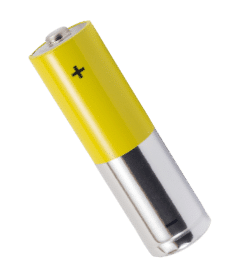PRIMARY BATTERIES
Primary batteries can be used in electrical appliances, photographic equipment, watches, computers and many other devices we use daily.
Most primary batteries are cylindrical, flat or coin (button) with less than 20 Ah capacity. They are usually for domestic use, unlike secondary ones, which are generally for industrial use. The main types of primary batteries are:

Zinc / Carbon
The well-known simple batteries. For the simplest uses and with the shortest lifespan.
Silver
Usually button-shaped, they contain silver oxide and are mainly used in watches.
Zinc / Chloride
With a slightly longer lifespan. They are used where there are more significant energy requirements.
Zinc – air
Also, button-shaped, they have the innovation that atmospheric oxygen is used instead of a positive pole.
Alkaline Manganese
With a longer lifespan than the previous two species. They are even more environmentally friendly.
Mercury
With mercury oxide, it is mainly used in medical devices such as hearing aids. Unfortunately, the mercury they contain is dangerous for the environment.

Primary batteries are straightforward to use and have few maintenance requirements. In addition, they can have such a shape and size that they adapt to any device. Finally, they are reliable and affordable with a good lifecycle, energy and power density.
SECONDARY BATTERIES
Secondary batteries are electrically rechargeable and can be used almost anywhere. They are divided into three central systems:

Rechargeable nickel-cadmium system
The first rechargeable batteries ever made. They are used in power tools, mobile phones, laptops, toys, etc., with a lifespan of 4-5 years. Unfortunately, cadmium is harmful. So efforts are being made to remove this type of battery from the market and, where possible, to replace it.
Rechargeable lead system
Their discovery revolutionised the automotive industry since most car batteries belong to this category. Unfortunately, lead is also dangerous for the environment, so efforts are already being made to collect empty batteries from car workshops and send them for recycling.
Lithium
Long-lasting, they contain lithium metal and are widely used in photographic equipment and mobile phones.
Nickel-metal hydride system
They are more environmentally friendly than Ni-Cd, which they tend to replace with a longer lifespan.

Rechargeable batteries present many advantages, economically and technologically. The same battery can be used many times, quickly amortising its purchase cost. They operate at high and low temperatures and have a very high efficiency for most of their work.


- Some of the electrical devices that we use every day and their operation requires batteries are the following:
- Cassette players
- Radios
- Portable audio devices
- Pocket slot machines
- Toys (remote control, dolls, etc.)
- Mobile phones
- Wireless phones
- Cars
- Laptops
- Flashlights
- Clocks
- Cameras
- Power drills and other portable tools
- Video cameras
- Hearing Aids
- Walkie Talkie
- Remote controls, etc.


And these are just some of the ones we use at home. Most of the batteries are used in industry and by professionals for portable devices they need in their work. Also, batteries are used to produce electricity (electrical accumulators) that store it until it is sent to our homes.
Why we should recycle lithium batteries
- Lithium batteries are the primary type of rechargeable battery – once emptied, they can be recharged for repeated uses.
- Lithium batteries can ignite or explode if not recycled properly
- Recycling is the ideal method for lithium batteries, as landfilling and incineration take a significant toll on the environment
- Through recycling, critical raw materials are extracted, which, in addition to the environment, also help in the more efficient and cost-effective production of new resources
- Lithium batteries are commonly used in devices such as Bluetooth headsets, cell phones, digital cameras, laptops, smartwatches, flashlights, some toys, remote control devices, tools, and drones

